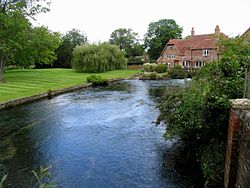Boxford, Berkshire
| Boxford | |
| Berkshire | |
|---|---|
 Watermill at the centre of the village | |
| Location | |
| Grid reference: | SU428715 |
| Location: | 51°26’28"N, 1°22’48"W |
| Data | |
| Population: | 466 (2001) |
| Post town: | Newbury |
| Postcode: | RG20 |
| Dialling code: | 01488 |
| Local Government | |
| Council: | West Berkshire |
| Parliamentary constituency: |
Newbury |
| Website: | Boxford.org.uk |
Boxford is a village in Berkshire, on the east bank of the River Lambourn, about 4 miles northwest of Newbury, and standing just south of the M4 motorway. The associated hamlet of Westbrook is on the opposite bank of the river.
The village has a number of thatched cottages and a watermill.
Parish church
The parish church of St Andrew consists of a chancel, nave, north aisle, north-west vestry, south porch and a west tower. The chancel may be Anglo-Saxon, and a Saxon window was discovered in a wall of the church in 2011.[1] The Jacobean pulpit dates from 1618,[2] the font from about 1662[2] and the west tower from about 1692.[3]
Much of the church was rebuilt in the Victorian era and in 1841 the north aisle was added.[3] However, the arcade between the nave and north aisle was probably by John Oldrid Scott and Sons in 1908.[3]
Archaeology
A number of Bronze Age features have been recorded near Boxford and an urn of this period has been found. A hearth and pottery fragments from the Iron Age, including a La Tène pot, have been found near the north end of Boxford Common.[4] Iron Age pottery fragments and a possible earthwork have also been found near Borough Hill[5]
Mud Hall Cottage on Wyfield Farm is the site of a large Roman building which was excavated about 1870.[6] Roman pottery and coins have been found at Boxford Rectory.[7] The course of Ermin Street, the Roman road that linked Corinium Dobunnorum (Cirencester) and Calleva Atrebatum (Silchester) passes through the south of the parish. A 140-yard section is visible from aerial archaeology near William's Copse.[8]
Manor
In AD 958 King Eadred granted property at Boxore to his servant Wulfric, and in 968 King Edgar the Peaceful granted a similar amount of property here to his servant Elfwin.[9] Both men ceded their holdings to Abingdon Abbey, which thus held the whole manor of Boxford before the Norman Conquest.[9]
The Domesday Book of 1086 records Boxford as Bochesorne. It says under the list of lands that belonged to Abingdon Abbey:
Of the land in this manor, Reinbold holds Leckhampstead 10 hides and William 4 hides at Weston and Berner 2 hides at Boxford... There is land for 11 ploughs. There are three ploughs and 12 villeins and 24 bordars with six ploughs and six four slaves and two acres of meadow and a church. It is and was worth 10 pounds.[10]
Boxford House is a Grade II listed country house which is believed to date from 1825. It is built of ashlar masonry in a Gothic revival style, with mullioned and transomed windows. It has a slate roof and a parapet.[11]
Big Society
Boxford is known for the Boxford Masques, an outdoor midsummer celebration held on Hoar Hill in the unspoiled woodland above the village overlooking the Lambourn Valley.
The Masques were originally created in the late 19th century by a local writer, Charlotte Peake with her love of music, drama and poetry. The Boxford Masques was performed by locals and lasted only up until the First World War. It was revived in the year 2000 by the Watermill Theatre of Bagnor, near Newbury; it has been very popular since. The 2012 production, performed at the nearby Welford House, was named 'A Little Drama at the Big House' and told the story of the founding of the plays, based on fact and re-imagined by Geraldine McCaughrean.
Outside links
| ("Wikimedia Commons" has material about Boxford, Berkshire) |
References
- ↑ "Saxon window sheds light on Boxford's past". Diocese of Oxford. http://www.oxford.anglican.org/the-door/news/saxon-window-sheds-light-on-boxfords-past.html. Retrieved 1 April 2011.
- ↑ 2.0 2.1 Pevsner, 1966, page 93
- ↑ 3.0 3.1 3.2 Pevsner, 1966, page 92
- ↑ National Monuments Record: No. 233551
- ↑ National Monuments Record: No. 233581
- ↑ National Monuments Record: No. 233554
- ↑ National Monuments Record: No. 233557
- ↑ National Monuments Record: No. 1307472
- ↑ 9.0 9.1 Page & Ditchfield, 1924, pages 44–48
- ↑ Domesday Book: A Complete Translation. London: Penguin Books. 2003. p. 142. ISBN 0-14-143994-7.
- ↑ Boxford House - Royal Berkshire History
- A History of the County of Berkshire, Volume 4 - Victoria County History
- Pevsner, Nikolaus (1966). Berkshire. The Buildings of England. Harmondsworth: Penguin Books. pp. 92–93.